Camosun Bog is a small peatland sitting on the edge of Pacific Spirit Park (formerly Endowment Lands of the University of British Columbia).  The formation of this wetland took thousands of years, achieving “bogdom” approximately 2,000 years ago – only a remnant remains; in less than a century, logging, fires, and more seriously, urban development changed the landscape. Altered hydrology had a detrimental impact on the unique bog plants, in fact very little Sphagnum persisted by 1985. Almost as soon as Pacific Spirit Park was established in 1990 the Greater Vancouver Regional District and the Vancouver Natural History Society took action and had 150 hemlock trees removed using helicopters. This of course did not solve the problem and indeed created new ones, but with the trees out of the way work could begin.
The formation of this wetland took thousands of years, achieving “bogdom” approximately 2,000 years ago – only a remnant remains; in less than a century, logging, fires, and more seriously, urban development changed the landscape. Altered hydrology had a detrimental impact on the unique bog plants, in fact very little Sphagnum persisted by 1985. Almost as soon as Pacific Spirit Park was established in 1990 the Greater Vancouver Regional District and the Vancouver Natural History Society took action and had 150 hemlock trees removed using helicopters. This of course did not solve the problem and indeed created new ones, but with the trees out of the way work could begin.
 In 1995 the Camosun Bog Restoration Group was established. This dedicated group of volunteers, have worked tirelessly removing debris and re-establishing the wetland. A combination of substrate removal to bare peat (lowering the water table) and various experiments on Sphagnum and peatland rehabilitation are successfully bringing this bog back to life. Today you can see it as a work in progress. A boardwalk around the perimeter offers views from all angles. You can see areas of well-established Sphagnum, recent transplants, sites being prepped for planting, as well as areas where invasives, such as Juncus and Dulichium, are in the process of being removed.
In 1995 the Camosun Bog Restoration Group was established. This dedicated group of volunteers, have worked tirelessly removing debris and re-establishing the wetland. A combination of substrate removal to bare peat (lowering the water table) and various experiments on Sphagnum and peatland rehabilitation are successfully bringing this bog back to life. Today you can see it as a work in progress. A boardwalk around the perimeter offers views from all angles. You can see areas of well-established Sphagnum, recent transplants, sites being prepped for planting, as well as areas where invasives, such as Juncus and Dulichium, are in the process of being removed.
What is a Bog?
Bogs generally get a bad rap: getting bogged down, slog in the bog, going to the bog…..
A bog is a type of wetland that is dominated by Sphagnum moss (aka peat moss). It differs from other wetlands in that its source of nutrients and water is from precipitation.
Bog formation is the result of a combination of conditions:
(a) Extremely wet: annual precipitation exceeds water loss.
(b) Poor drainage (impermeable below), moisture and nutrients mostly supplied by rain or fog
(c) Acidic, low nutrients (calcium)
(d) Mostly grow in cooler temperatures
These conditions result in:
- Low decomposition, formation of peat, accumulation exceeds decomposition, storage of nutrients and carbon
- Conditions really good for preserving things (pollen dating and vegetation information), bog people
How bogs are formed?
Bogs start to develop from wet depressions, such as ponds and lakes, where drainage is impeded. Often wetland species, such as sedges, are initially growing at the margins. As debris builds up and the water becomes more acidic Sphagnum grows from the margins inward. Sphagnum further acidifies the environment by virtue of the cation exchange system in its cell walls. Cations, such as calcium, are taken up and a proton (H+) is released making the surroundings more acidic. The pH becomes even lower as through the production of humic acid during
The keystone species in a bog is Sphagnum. Check out the BIOL 321 (UBC) website for more information about this amazing moss!
For more Information:
Camosun Bog Restoration Group Website
Hermansen, S. and G. Wynn. 2004 Reflections on the nature of an urban bog. Urban History Review, 34:1, pages 9 – 27.
Pamphlet from Fieldtrip (2009) – includes species checklist
